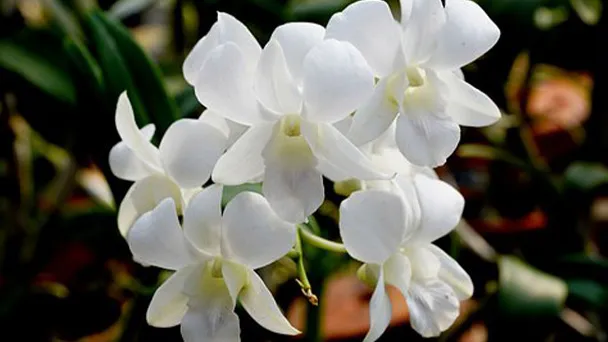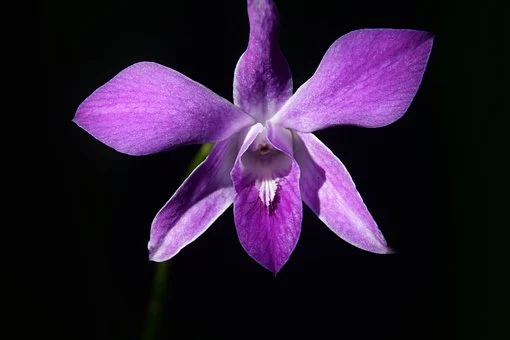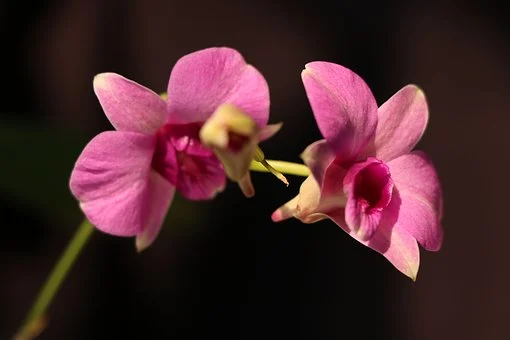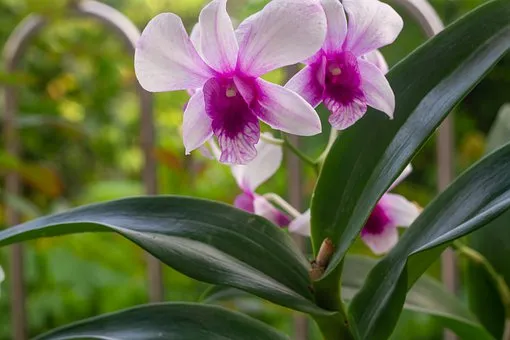How to Grow and Care for Dendrobium Orchid
Written by Ivy
Jan 06 2023

Dendrobium orchid is mainly distributed in tropical and subtropical Asia. Dendrobium orchid likes warm, humid and semi cloudy environment and is not resistant to cold. The optimum growth temperature is 18 ~ 30 ℃. Dendrobium orchid should avoid drying and ponding, especially when new buds begin to germinate and new roots form. However, if it is too wet, it is easy to cause Dendrobium orchid to rot in case of low temperature. Dendrobium orchid prefers light, with sufficient sunshine, good flowering in autumn and a large number of flowers.
 The most suitable planting season of Dendrobium orchid is late autumn, followed by early spring. The growth characteristics of Dendrobium orchid itself are dormancy in summer and growth in spring and autumn. Among them, spring is the most prosperous. Therefore, during the planting period of Dendrobium orchid, we should avoid the peak growth season, which is the first primary principle. The planting of Dendrobium orchid should avoid high temperature season and cold season. High temperature will cause serious water loss due to plant transpiration, and then affect the survival rate. The best planting period of Dendrobium orchid is the interval between growth stagnation period and growth start period. So late autumn is the best time to plant Dendrobium orchid.
The most suitable planting season of Dendrobium orchid is late autumn, followed by early spring. The growth characteristics of Dendrobium orchid itself are dormancy in summer and growth in spring and autumn. Among them, spring is the most prosperous. Therefore, during the planting period of Dendrobium orchid, we should avoid the peak growth season, which is the first primary principle. The planting of Dendrobium orchid should avoid high temperature season and cold season. High temperature will cause serious water loss due to plant transpiration, and then affect the survival rate. The best planting period of Dendrobium orchid is the interval between growth stagnation period and growth start period. So late autumn is the best time to plant Dendrobium orchid.

First, excavate the soil around Dendrobium orchid, then put the fertilizer in, and then fill the soil and pour water. If it is water-soluble fertilizer, you can try to dissolve it with water, and then sprinkle it on the leaves or pour it directly with water. We can apply fertilizer to Dendrobium orchid less each time and more times.
If we find that the longer the leaves of Dendrobium orchid, the smaller the size, the thinner the thickness and the lighter the color, it's like a person with yellow complexion and thin flesh, which means that the soil nutrients are not enough. We need to change the pots and supplement the soil. We can remove the plant from the pot, gently press the matrix mass of the root with our hands, loosen the matrix bark, and then sort out the matrix in the root. We should also determine the length of the reserved roots according to the size of Dendrobium orchid. The larger the plant, the longer the reserved roots will be. Generally, the length of the grass and flower roots is only about 15cm, and the excess part will be cut off. In addition, the dead branches and leaves or sick parts of the plant should also be cut off.
Vermiculite, pearl stone and bark can be fully mixed in the ratio of 1:1:3 as the new basin substrate of Dendrobium orchid repotting. We can add the mixed matrix into the new basin, about 1 / 3 of the height, compact it slightly by hand, put it into Dendrobium orchid plant, and then add the matrix until it is eight full.
Dendrobium Orchid Quick InfoWhen to Plant Dendrobium OrchidWhen does Dendrobium Orchid Bloom & HarvestDendrobium Orchid Care in DetailDendrobium Orchid WateringDendrobium Orchid SoilDendrobium Orchid LightDendrobium Orchid TemperatureDendrobium Orchid HumidityDendrobium Orchid FertilizerDendrobium Orchid PruningDendrobium Orchid RepottingDendrobium Orchid Pest & Disease ControlDendrobium Orchid PropagationDendrobium Orchid Propagation from CuttingDendrobium Orchid Propagation from DivisionDendrobium Orchid Benefits1. Beautify the environment2. Anti aging3. Enhance the body's disease resistance4. Protect cardiovascular and cerebrovascular
Dendrobium Orchid Quick Info
| Botanical/Scientific Name | Dendrobium Orchid |
| Common Name | Dendrobium |
| When to Grow/Bloom/Harvest | Bloom from February to September |
| Uses | Corsages and wedding work |
| Origin | Japan, New Guinea, Australia and South-East Asia |
| Light Care | Lightly shaded south window |
| Soil Care | Moist but well-drained |
| Temperature Care | 65-85 °F (18-30°C) |
| Humidity Care | 50-70% humidity |
| Watering | Water every 1-2 weeks |
| Pruning Care | Trim the flowers off as they fade |
| Fertilizer Care | Balanced fertilizer |
| Propagation | Cuttings |
| Toxic | Non-toxic to cats |
| Flower Color | From white through pink and purple |
When to Plant Dendrobium Orchid

When does Dendrobium Orchid Bloom & Harvest
If the environment we provide during the maintenance of Dendrobium orchid is suitable, it can bloom from February to around November, that is, it may bloom except in winter. When Dendrobium orchid blooms, it has gorgeous flower color and beautiful flower posture, which has high ornamental value. However, if we want Dendrobium orchid to blossom better and longer, we should pay attention to the usual maintenance and management. Dendrobium orchid likes a warm environment. The temperature should be controlled between 15 and 20 degrees. Dendrobium orchid also has requirements for humidity. When the climate is dry, spray water frequently and supplement fertilizer in time in peak growth season.Dendrobium Orchid Care in Detail
Dendrobium Orchid Watering
During the four seasons of the year, great attention should be paid to watering denprobium orchid. When watering in spring, summer and autumn, we'd better do it from 9:00 to 11:00 in the morning, and in winter, we'd better do it around 4:00 in the afternoon. In the process of curing denprobium orchid, we must maintain it in a ventilated and humid environment, Do not water at high temperature. In winter, the temperature is relatively low. When the temperature drops below 10 ℃, Dendrobium orchid will go into dormancy. At this time, we'd better not water Dendrobium orchid. When the temperature rises above 10 ℃, we can water properly.Dendrobium Orchid Soil
Dendrobium orchid is a shallow rooted plant, which is also air rooted. It cannot grow in general soil. It has some requirements for soil quality. The soil of Dendrobium orchid should be breathable, drained and loose. There are many kinds of plant materials that can be selected for Dendrobium orchid soil. We can choose to mix peat soil, pine bark and peanut shell, pine bark, small wood blocks and rotten leaf soil, and rotten leaf soil, coconut bark, moss and sawdust as the matrix.Dendrobium Orchid Light
We all know that the growth of Dendrobium orchid has phototaxis. When the direction of the flowerpot is fixed, Dendrobium orchid will unconsciously grow in the direction of the sun, which will cause the bending of plant branches and stems for a long time and affect the ornamental value of flowers. We only need to rotate the flowerpot every other period of time so that the plants can enjoy the light evenly. The flowers are naturally upright and straight. The time interval of rotating the flowerpot is the most appropriate cycle of about seven days. Dendrobium orchid needs to receive an appropriate amount of light. When the light is strong in summer, pay attention to shade the plants to ensure that the flowers avoid direct sunlight. Put the sunburned plants in a cool and ventilated place for maintenance. We can open the windows in the right weather, which is conducive to indoor ventilation and reduce the propagation of bacteria.Dendrobium Orchid Temperature
For Dendrobium orchid, temperature is extremely important. Dendrobium orchid is a plant that is afraid of cold. Most Dendrobium orchid are suitable for 10-35 degrees Celsius. The temperature for autumn Dendrobium is generally not lower than 10 degrees Celsius, and that for spring Dendrobium is generally not lower than 5 degrees Celsius. Moreover, the temperature should not be too high when Dendrobium orchid grows flower buds in spring, otherwise the flower buds will stop developing, Turn into leaf buds.
Dendrobium Orchid Humidity
We should keep the humidity around Dendrobium orchid at 50-70%. Grasping the humidity can be said to be the most prerequisite for the growth of Dendrobium orchid. Appropriate humidity can accelerate the growth of plants, especially the performance of newly sprouted buds. In the actual planting process, it is found that the Dendrobium orchid branches with sufficient water supply and good moisture can become strong, full and shiny in a few days, that is, the appropriate humidity can make the whole Dendrobium orchid grow vigorously and strong.Dendrobium Orchid Fertilizer
First of all, it is necessary to determine that the fertilization temperature for Dendrobium orchid is between 15 and 30 C, which is more suitable for topdressing. If you are not in this range, you need to be cautious. Nitrogen fertilizer can be added to Dendrobium orchid during growth period, and potassium and phosphorus fertilizer can be added during flowering and fruit bearing. Topdressing should not be carried out at noon in summer and autumn, but preferably in the evening without sun.First, excavate the soil around Dendrobium orchid, then put the fertilizer in, and then fill the soil and pour water. If it is water-soluble fertilizer, you can try to dissolve it with water, and then sprinkle it on the leaves or pour it directly with water. We can apply fertilizer to Dendrobium orchid less each time and more times.
Dendrobium Orchid Pruning
- Dormancy pruning
- Growing season pruning
- Pruning after flowering
Dendrobium Orchid Repotting
Before changing the basin, we can look at the roots of potted plants. If their roots extend outside the basin, it certainly means that the basin is too small to accommodate the growing roots and needs larger containers and more soil.If we find that the longer the leaves of Dendrobium orchid, the smaller the size, the thinner the thickness and the lighter the color, it's like a person with yellow complexion and thin flesh, which means that the soil nutrients are not enough. We need to change the pots and supplement the soil. We can remove the plant from the pot, gently press the matrix mass of the root with our hands, loosen the matrix bark, and then sort out the matrix in the root. We should also determine the length of the reserved roots according to the size of Dendrobium orchid. The larger the plant, the longer the reserved roots will be. Generally, the length of the grass and flower roots is only about 15cm, and the excess part will be cut off. In addition, the dead branches and leaves or sick parts of the plant should also be cut off.
Vermiculite, pearl stone and bark can be fully mixed in the ratio of 1:1:3 as the new basin substrate of Dendrobium orchid repotting. We can add the mixed matrix into the new basin, about 1 / 3 of the height, compact it slightly by hand, put it into Dendrobium orchid plant, and then add the matrix until it is eight full.

Dendrobium Orchid Pest & Disease Control
- Soft rot disease: also known as bacterial brown spot disease, it mostly infects from the roots and stems, and can also occur on the leaves of Dendrobium orchid. The primary water stains are small dark green spots, which gradually expand into brown, soft and rotten. There are secretions flowing out of the rotten parts with odor. Germs can be spread by watering. High temperature and humidity are conducive to the occurrence of diseases. Once the infected Dendrobium orchid is found, it shall be isolated and destroyed in time, and controlled with agricultural streptomycin, Bordeaux liquid or methyl parathion.
- Black spot: this disease is the main disease endangering Dendrobium orchid, and the occurrence part is the leaf. At the initial stage, it is a small brown spot, and then it expands into a nearly circular lesion, with necrosis in the center. The lesion is grayish brown with a diameter of 0.5 ~ 1.0cm. When Dendrobium orchid is seriously ill, the disease spots are connected into pieces, which will cause the leaves to turn yellow and fall off. (Also Read: Why Is My Orchid Stem Turning Yellow)
- Aphid: it mainly endangers the young leaves and flower buds of Dendrobium orchid. It stabs into the epidermis with a thorn sucking mouthpiece to absorb plant juice nutrients, causing deformation and wilting of leaves and new buds, as well as disease invasion. We can strengthen ventilation and improve the cultivation environment. Combined with drug spraying, we can spray 1500 times of 20% pyrethroid and 1000 times of 40% Omethoate.
- Scale insects: common pests in the cultivation of Dendrobium orchid, mainly parasitic on the back of leaves or in leaf sheaths. It occurs in the environment with low air humidity and poor ventilation. At the initial stage of damage, the leaves turn yellow and affect photosynthesis. In serious cases, the plants die or can not grow and bloom normally. In addition to strengthening ventilation, when a small amount occurs, we can use a soft brush. 50% malathion or 25% jiemingjing 800 ~ 1000 times solution was sprayed once a week and continuously for 3 ~ 4 times.
Dendrobium Orchid Propagation
Dendrobium Orchid Propagation from Cutting
- Time selection
- Cut off branches
- Preparation of matrix
- Cutting
Dendrobium Orchid Propagation from Division
Dendrobium orchid propagation from division is a common propagation method in flower caring. It has good propagation effect and high survival rate. To put it simply, the Dendrobium orchid plants that grow together are separated and planted separately. It is also relatively simple to adopt the method of plant division propagation. Cut the base part of the old root cluster stem with a detoxified knife. Note that we try not to hurt the root system of the plant and grow the main plant alone. Compared with those Dendrobium orchid with good growth, lush growth and high germination rate, division propagation is a very suitable propagation method.Dendrobium Orchid Benefits
1. Beautify the environment
Dendrobium orchid is an elegant and generous ornamental plant with beautiful appearance and bright colors. It can be made into potted plants and placed indoors and in some office places, which can beautify the environment and delight the body and mind. In addition, Dendrobium orchid can absorb carbon dioxide in the air during breathing, convert them into oxygen, release them, and purify indoor air.2. Anti aging
When the tonic is eaten by people, it can not only improve the activity of superoxide dismutase in the human body, but also improve the antioxidant capacity of the human body, reduce the occurrence of oxidation, keep the human body young and healthy, and significantly improve the anti-aging ability of the human body.3. Enhance the body's disease resistance
Usually, after people eat Dendrobium Orchid, they can also improve the disease resistance of the body, because the food basket is rich in Dendrobium polysaccharides, some amino acids and some trace elements. They can regulate the immune function of the human body, promote the regeneration of immune cells, and enhance the anti-virus ability of the human body. Regular consumption can significantly improve the quality of the human body and enhance the disease resistance.4. Protect cardiovascular and cerebrovascular
Dendrobium orchid also has an obvious protective effect on human cardiovascular and cerebrovascular. It can not only prevent vascular aging, but also improve vascular elasticity and toughness, and promote blood circulation. In addition, it can also improve the activity of platelets in human body, prevent platelets from condensing into thrombus, and has an excellent preventive effect on human high-risk arteriosclerosis, thrombosis, stroke and other common diseases. Dendrobium orchid also contains some phenanthrene and benzenes, which can resist virus and prevent cell carcinogenesis. People usually eat more Dendrobium orchid can also prevent cancer.Latest Updated
- Benefits of Bugleweed - 7 Science-backed Health Benefits
- Bugleweed Dangers & Side Effects - Is It Poisonous?
- How to Plant Evergreen Trees - What You Should Know
- When to Plant Evergreens - Grow Guide for Evergreen Trees
- 12 Wonderful Evergreen Shrubs for Your Garden
- 12 Popular Evergreen Plants with Pictures for Beginners
- When And How To Prune A Lilac Bush Like a Pro
- How to Grow & Care for Lilac Vine (Hardenbergia Violacea)
- Japanese Lilac Tree (Syringa Reticulata) Care & Propagation Guide
- Shumard Oak Pros and Cons - What to Know
Popular Articles
- Winter maintenance of Antirrhinum Majus
- How to Grow Terminalia Mantaly Tree
- How to Grow and Care for Crossostephium Chinense
- How to grow Antirrhinum Majus in spring
- Peristeria Elata (Dove Orchid) Profile: Info & Care Guide
- Underwatered Snake Plant (Sansevieria Trifasciata) - Signs And How To Fix
- How to Care for Brazilian Jasmine Plant (Mandevilla Sanderi)
- How to Grow & Care for Graptopetalum Purple Delight in Summer
- Rosa Chinensis (China Rose): Plant Growing & Care Tips
- How to Care for Baby Sun Rose (Aptenia Cordifolia)